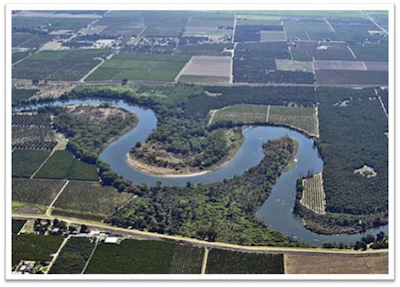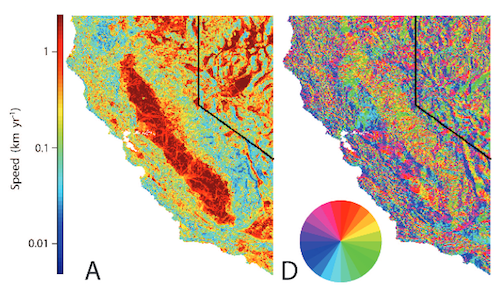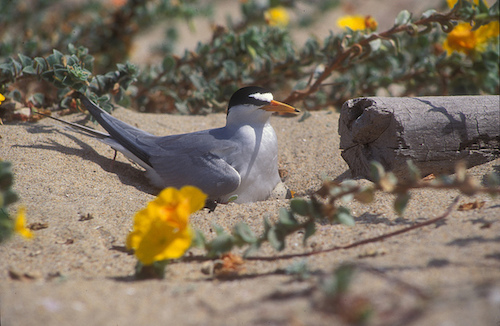Biodiversity and Climate Change
The impact of climate change on biodiversity has engendered much research, both within California and worldwide. The following summarizes much of the research directly concerning California, and identifies a few important resources more global in scope that are especially pertinent to management.
Biodiversity management:Staudinger et al. 2013 provides a synthesis of the current research concerning biodiversity and climate change as well as management implications on a global scale. Heller and Zaveleta 2009 review two decades worth of research on conservation in the face of climate change, tabulating the set of recommendations from 113 papers. Abrahms et al. 2017 synthesize key considerations in integrating climate change adaptation into management, and review three leading frameworks for incorporating climate change adaptation into conservation planning.Millar et al. 2007 discuss a variety of approaches for managing forests, including adaptive responses (resistance, resilience, and response) and mitigation, and this framework is developed further by Stephens et al. 2010 within Mediterranean ecosystems. Peterson et al. 2012 from the US Forest Service provide a comprehensive guidebook for National Forests to develop adaptation options for climate change. Littell et al. 2012 discuss how to bring scientific knowledge into the forest management process, testing out a focus group approach on two National Forests. The impact of implementing mitigation strategies on a global scale is analyzed by Warren et al. 2013, who quantify mitigation success in terms of reduced climatic range losses for 48,768 widespread species. With regards to management of biodiversity specifically within California, Barbour and Kueppers 2011 review the piecemeal regulatory framework that exists within the state and discuss potential adaptation strategies. Klausmeyer et al. 2011 derive a set of landscape-level indicators to perform a vulnerability assessment to climate change for biodiversity in California. Morelli et al. 2011 use the Inyo National Forest as a case study in how to combine climate projections with a dynamic vegetation model to produce a range of adaptation options. Seavy et al. 2009 suggest that riparian ecosystems are especially important for adaptation to climate change because of their connectivity properties. |
 Riparian ecosystems provide habitat connectivity, link aquatic and terrestrial ecosystems, and create thermal refugia for wildlife: characteristics that contribute to ecological adaptation to climate change. Seavy et al. 2009. Photo from DWR. |
 Left: Velocity of climate change for temperature. Velocity is the distance per year an organism would have to move to stay within the same temperature regime. Right: Direction (right) of climate change for temperature. Colors on the compass wheel represent the direction of movement in space to offset projected changes in climate. From Ackerly et al. 2010. |
Biogeography and Ecosystems:Ackerly et al. 2010 model how climate heterogeneity at a local scale changes under two climate projection scenarios for California and discuss the importance of capturing topoclimate diversity within a reserve network. Shaw et al. 2011 use dynamic vegetation modeling to predict how two ecosystem services in California, forage production for livestock and carbon sequestration, would be affected by climate change. Albano 2015 presents a new approach for selecting protected areas in which geophysical diversity is used as a surrogate for species diversity and adaptive capacity. Modeling tools and techniques:Hannah et al. 2008 have developed a dynamic vegetation dispersal and disturbance model named BioMove that they have used to forecast ranges for blue oak, Joshua tree, sugar pine, and invasive grasses under climate change. Dobrowski et al. 2010 use a set of vascular plant species for California for which there was range data from both the 1930s and today to test the proposition that species distribution models can predict new ranges given changes in climate. Warren et al. 2013 explore the implications of model complexity and spatial sampling bias on niche modeling by focusing on data that includes 90 California species. |
Plants and Vegetation:There are many studies that are concerned with the impacts of climate change on California's flora and vegetation. In model-based studies, Loarie et al. 2008 examine potential range shifts of 2387 species of endemic plants due to climate, and Lenihan et al. 2003 use a dynamic vegetation model to look at shifts in vegetation productivity, carbon content, and fire area due to climate change. Thorne et al. 2017 use two GCMs to assess the exposure of Southwestern forests to clmate change. Sandel and Dangremond 2012 look at a number of traits of native versus exotic grasses in California and correlate these with climate patterns. McGlaughlin and Zaveleta 2012 look at differences in distribution patterns between saplings and adult valley oaks in considering responses to climate change. Sork et al. 2010 examine how genetic variation in valley oaks could interact with predicted patterns of climate change. Thorne et al. 2006 compare vegetation maps from the 1930s era Vegetation Type Mapping project to a 1996 map of the Central Sierras and discuss possible reasons for changes in patterns. Millar, Westfall, and Delany 2007 consider a drought-associated mortality event for limber pine in the eastern Sierra Nevada and discuss its relevance to climate change impacts. Dolanc et al. 2012 resampled vegetation plots in Sierran subalpine forest originally sampled in the 1930s and related these to shifts in climatic conditions. Building upon a concept of water deficit developed in Stephenson 1998, Crimmins et al. 2011 argue how changes in water balance regimes have led some plant species in California to shift their ranges downhill (though see discussion in Stephenson and Das 2011, Hijmans 2011, Wolf and Anderegg 2011, with a followup by Dobrowski et al 2011). Franklin et al. 2013 use an integrated modeling framework to gauge the impacts of a number of interacting threats on 5 California plant species as well as the effectiveness of several management strategies. Das et al. 2013 and Bonebrake et al. 2014 similarly emphasize the importance of considering multiple threats when assessing plant mortality and climate-related range shifts. McGlaughlin et al. 2017 use the case of California's oak woodlands to examine the role of hydrologic processes to create mesic microrefugia for plants and other sessile organisms. Fernández et al. 2015 look at historical analogs to GCM projections to evaluate potential suitable for coast redwoods and propose that working with historical climate data may be useful in modeling situations where local climate is strongly influenced by ocean-atmosphere dynamics. |
Fish and Invertebrates:Forister et al. 2010 analyze 35 years of butterfly diversity transect data across a gradient running up the Sierra Nevada mountains and relate upward shifts in species ranges to climate change. For fish, Wagner et al. 2011 develop projections of water temperatures under climate change for the Sacramento-San Joaquin Delta and relate these to temperature thresholds for the threatened delta smelt. Quinones et al. 2014 presents a comprehensive analysis of multiple factors that influence the survival of California salmonids, and Moyle and Quinones assessed the predicted effects of climate change on California's inland fishes, finding that fifty percent of California’s native fish fauna have high vulnerability to extinction whereas alien species are less vulnerable and some benefit from climate change. Yates et al. 2008 look at the effects of climatic warming on temperature regimes in the Sacramento River and consider impacts on Chinook salmon, taking into account management possibilities for cold water storage in reservoirs upstream. |
|
Birds:Looking at historical data, Tingley et al. 2009 resurvey bird transects performed nearly a century ago in the Sierra Nevadas and compare the results to expected range shifts due to climate. Siegel et al. 2014 predict vulnerability to climate change in 168 Sierra Nevada breeding bird species. Performing species distribution modeling, Stralberg et al. 2009 note that climate change may result in the formation of bird communities in California that have no analog in the past or present. Gardali et al. 2012 carry out a vulnerability assessment that augments the California Bird Species of Special Concern list by considering sensitivity to climate change. Morrison et al. 2011 consider management options in the face of climate change for the island scrub jay, a passerine species endemic to Santa Cruz Island off the Santa Barbara coast. There are several bird-related datasets from Point Blue Conservation Science and the Climate Commons that are freely available, including Bird Distribution Responses to Climate Change, Bird Community Turnover, Bird Species Richness Response to Climate Change, and Conservation Prioritization for California Landbirds. |
 The California least tern is a Bird Species of Special Concern with a high climate change vulnerability ranking. Photo from USFWS. |
Amphibians and Reptiles:There has been some recent research conducted on how climate change will affect reptile species found in California’s deserts. Barrows 2010 uses niche modeling to predict the impact of climate change and drought variability on the sand dune restricted fringe-toed lizard Uma inornata, while Barrows 2011 analyzes the sensitivity to climate change of two Mojave-Sonoran desert species: the common chuckwalla (Sauromalus ater) and the desert tortoise (Gopherus agassizii). The threatened Gopherus agassizii is also the focus of Lovich et al. 2014, who use historical and current population statistics to predict how climate change-induced drought may impact future survivorship. Barrows et al. 2014 examine how four sympatric Sceloporus species have been able to cope with climatic variations by comparing past and present species ranges to predict how future climate change will influence their distributions. Amphibians have been classified as one of the most climate change vulnerable groups due to the additive effects of climate change on other stressors. Some recent studies pertinent to California include Padgett-Flohr and Hopkins 2010 who investigate how climate change interacts with the spread of chytrid fungus (Batrachochytrium dendrobatidis) in amphibian populations in Central California, and Ryan et al. 2014 who analyze the vulnerability of wetland amphibian populations in the Western U.S. to climate change and non-native species introduction. There is a substantial amount of literature available on the relationship between climate change and amphibian biodiversity decline, but it extends past the range of California and is more global in scale. Mammals:Moritz et al. 2008 resurvey Joseph Grinnell's small mammal transects in Yosemite National Park from nearly a century ago and relate the changes to warming temperatures. Rowe et al. 2014 expand on this by resampling 34 small mammal species to determine if species response to climate change is spatially consistent. Stewart et al. 2015 suggest that temperature will play a key role in future distributions of pikas in California by analyzing current and historic distribution data using a simple species distribution model. A novel water-balance approach to modeling past, current, and future snowpack in the Sierra Nevada’s is presented by Curtis et al. 2014 as a management approach for preserving the habitat of snow-dependent species. |
To find more resources on this topic, please click on the subject tags below.
10/2017
